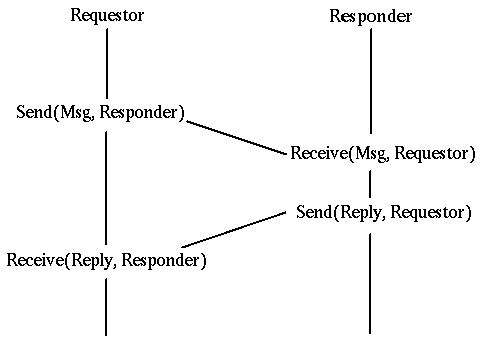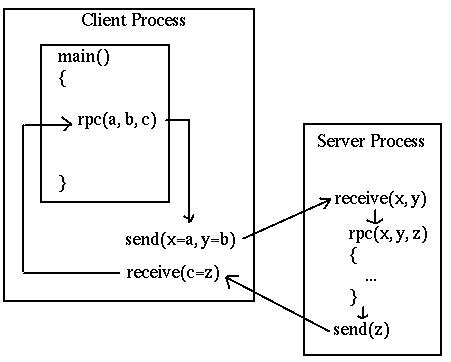Communications Models
Message passing
Some non-procedural languages are built on the principle of message passing. Concurrent languages often use such a mechanism, and the most well known example is probably the Unix pipeline. The Unix pipeline is a pipeline of bytes, but there is not an inherent limitation: Microsoft's PowerShell can send objects along its pipelines, and concurrent languages such as Parlog could send arbitrary logic data structures in messages between concurrent processes.
Message passing is a primitive mechanism for distributed systems. Set up a connection and pump some data down it. At the other end, figure out what the message was and respond to it, possibly sending messages back. This is illustrated by

Low level event driven systems such as the X Window System function in a somewhat similar way: wait for message from a user (mouse clicks, etc), decode them and act on them.
Higher level event driven systems assume that this decoding has been done by the underlying system and the event is then dispatched to an appropriate object such as a ButtonPress handler. This can also be done in distributed message passing systems, whereby a message received across the network is partly decoded and dispatched to an appropriate handler.
Remote procedure call
In any system, there is a transfer of information and flow control from one part of the system to another. In procedural languages this may consist of the procedure call, where information is placed on a call stack and then control flow is transferred to another part of the program.
Even with procedure calls, there are variations. The code may be statically linked so that control transfers from one part of the program's executable code to another part. Due to the increasing use of library routines, it has become commonplace to have such code in dynamic link libraries (DLL-s), where control transfers to an independent piece of code.
DLLs run in the same machine as the calling code. It is a simple (conceptual) step to transfer control to a procedure running in a different machine. The mechanics of this are not so simple! However, this model of control has given rise to the "remote procedure call" (RPC) which is discussed in much detail in a later chapter. This is illustrated by

There is an historical oddity called the "lightweight remote procedure call" invented by Microsoft as they transitioned from 16-bit to 32-bit applications. A 16-bit application might need to transfer data to a 32-bit application on the same machine. That made it lightweight as there was no networking! But it had many of the other issues of RPC systems in data representations and conversion.